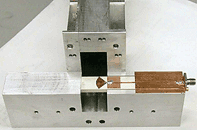
Scale Model Measurements |
Electric Field Distribution |
Rendering of Radial Probe Transition |
Performance Curves:
J.W. Kooi, G. Chattopadhyay, S. Withington, F. Rice, J. Zmuidzinas, C.K. Walker, and G. Yassin
IR & MM Waves, Vol. 24, No. 3, March 2003.
S. Withington, G. Yassin, J. Leech, and K.G. Isaak, B,
An Accurate Expression for the Input Impedance of One-Sided Microstrip Probes in Waveguide
Frank Rice
For the low frequency (230 GHz and 345 GHz) bands 25µm suspended Silicon or GaAs substrates can be used. In order to
avoid subrate modes, the higher
frequency bands require the silicon (GaAs) substrate to be thinned (==> membrane). If this is not practical
suspended quartz substrates with lower dielectric constant may be used. In our designs we anticipate the use of 50 µm
Quartz Substrates. The actual Probe impedance scales with
the square root of the ratio of dielectric constants, i.e. 1.77. Though the actual probe impedance is very
dependent on the actual RF Choke and WG geometery, the silicon Probe impedance locus is on the order of
28 Ω, and the Quartz probe impedance is ~ 45 Ω.
All mixers will be implemented in FULL HEIGHT waveguide, which reduces Ohmic loss and eases manufacturablility.